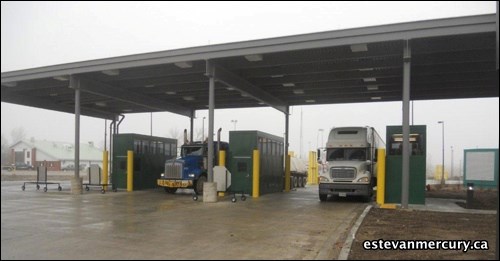It encountered some delays and a suspension of the original contract, but after more than four years the new United States Portal Port of Entry is now open.
The official opening was marked on Oct. 31 with the completion of the $43 million project.
Brian King, of the United States Customs and Border Protection, noted the previous border station was built in 1931, so the building was due for an upgrade considering the changes in the kinds of vehicles and quantity that go through the port on a daily basis.
"Our border operations have changed significantly since 1931, and our traffic patterns have changed significantly," he said. "The new facility offers a couple of things the old one did not."
The new port of entry was upgraded as a singular project, noted King. The America Recovery Act mandated the upgrade of 31 ports of entry, including the Noonan port, which was unveiled last fall. The Portal border crossing was not part of that initiative.
"This was a planned construction, where those were part of the ARA," said King. "This was separate from those builds."
Construction began in the summer of 2008, and Sally Mayberry, regional public affairs officer for the U.S. General Services Administration (GSA), noted the original construction contract had to be suspended in January 2010. A "revised project scope" was put out to bid, she added, and it was awarded to Tetra Tech/RCSI in October 2010.
There were some design issues that had to be changed, particularly with joining up with the Canadian port.
"The main concern was how the original designed port of entry would affect outbound inspection processes and access to the Canadian port by outbound traffic," said Mayberry. "To address those concerns, GSA moved the entrance as originally designed on the western edge of the site to the eastern side of the site."
While there was only one lane for commercial traffic previously, there will now be three. There are also two passenger car lanes. Some of those lanes can accommodate both kinds of traffic so if there is a busy time for one kind of traffic, they can open an extra lane for the overload of vehicles.
Last year, the CBP processed more than 104,000 cars, an increase of 15 per cent, and more than 105,000 trucks, an increase of 35 per cent.
King noted their staff has grown since 1931 and it was one reason for the building of a new facility. He was unable to provide details as to how many people actually are working at the port, however.
"That's one of the areas that we're not allowed to speak on, anything staff related. Those numbers belong to the agency, and they don't allow us to comment on staffing. We will have staff available to manage the facility and manage the workflow," he assured.
The new facility has a detention area, complete with three cells, an important upgrade seeing as how the original facility did not have any.
King also said there is now an indoor firearms range and physical training room.
"It's a mat room for our handcuffing drills and our arm holds that we train on," said King. "The old one did not have either of those things."
There are also conference rooms and an enrolment centre office for their trusted traveller program.
An indoor inspection garage is another upgrade from the older building.
"This one is set up to actually do (multiple inspections)," he said. "It's a couple of bays, and it's got a vehicle lift, so we've got the ability to put a vehicle up on a lift if we need to."
The previous bay, he said, was mostly just an area where people could park their cars. The new one is equipped with lighting and air tools to ensure a more complete inspection.




